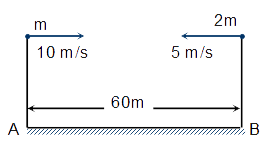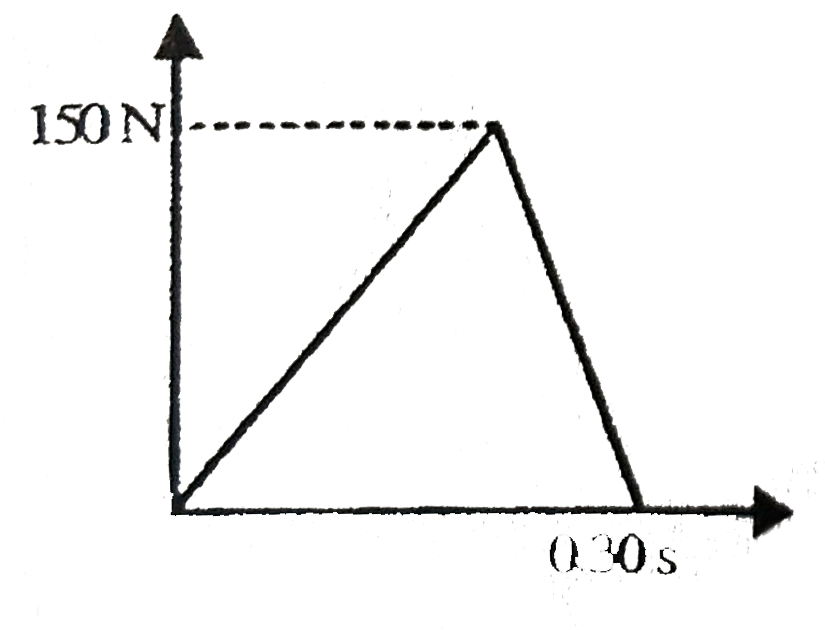Two bodies of masses 0.1 kg and 0.4 kg move towards each other with the velocities 1 m/s and 0.1 m/s respectively, After collision they stick together. In 10 sec the combined mass travels
120 m
0.12 m
12 m
1.2 m
The correct Answer is:D
To solve the problem step by step, we will follow these procedures:
Step 1: Identify the masses and velocities of the two bodies.
- Mass of body 1 (m1) = 0.1 kg, Velocity of body 1 (v1) = 1 m/s (towards the right).
- Mass of body 2 (m2) = 0.4 kg, Velocity of body 2 (v2) = 0.1 m/s (towards the left).
Step 2: Calculate the initial momentum of both bodies.
- The momentum of body 1 (p1) = m1 * v1 = 0.1 kg * 1 m/s = 0.1 kg·m/s (to the right).
- The momentum of body 2 (p2) = m2 * v2 = 0.4 kg * (-0.1 m/s) = -0.04 kg·m/s (to the left).
Step 3: Calculate the total initial momentum of the system.
- Total initial momentum (P_initial) = p1 + p2 = 0.1 kg·m/s - 0.04 kg·m/s = 0.06 kg·m/s.
Step 4: Apply the conservation of momentum principle.
- After the collision, the two bodies stick together, so their combined mass (M) = m1 + m2 = 0.1 kg + 0.4 kg = 0.5 kg.
- Let the final velocity after collision be V.
- According to the conservation of momentum: P_initial = P_final
- Therefore, 0.06 kg·m/s = M * V = 0.5 kg * V.
Step 5: Solve for the final velocity (V).
- Rearranging gives: V = P_initial / M = 0.06 kg·m/s / 0.5 kg = 0.12 m/s.
Step 6: Calculate the distance traveled in 10 seconds.
- The distance (d) traveled by the combined mass after the collision can be calculated using the formula:
d=V×t
- Where V = 0.12 m/s and t = 10 seconds.
- Therefore, d = 0.12 m/s * 10 s = 1.2 meters.
Final Answer:
The combined mass travels a distance of 1.2 meters in 10 seconds.
---
- Mass of body 1 (m1) = 0.1 kg, Velocity of body 1 (v1) = 1 m/s (towards the right).
- Mass of body 2 (m2) = 0.4 kg, Velocity of body 2 (v2) = 0.1 m/s (towards the left).
- The momentum of body 1 (p1) = m1 * v1 = 0.1 kg * 1 m/s = 0.1 kg·m/s (to the right).
- The momentum of body 2 (p2) = m2 * v2 = 0.4 kg * (-0.1 m/s) = -0.04 kg·m/s (to the left).
- Total initial momentum (P_initial) = p1 + p2 = 0.1 kg·m/s - 0.04 kg·m/s = 0.06 kg·m/s.
- After the collision, the two bodies stick together, so their combined mass (M) = m1 + m2 = 0.1 kg + 0.4 kg = 0.5 kg.
- Let the final velocity after collision be V.
- According to the conservation of momentum: P_initial = P_final
- Therefore, 0.06 kg·m/s = M * V = 0.5 kg * V.
- Rearranging gives: V = P_initial / M = 0.06 kg·m/s / 0.5 kg = 0.12 m/s.
- The distance (d) traveled by the combined mass after the collision can be calculated using the formula:
d=V×t
- Where V = 0.12 m/s and t = 10 seconds.
- Therefore, d = 0.12 m/s * 10 s = 1.2 meters.
The combined mass travels a distance of 1.2 meters in 10 seconds.
Topper's Solved these Questions
Similar Questions
Two particles A and B of equal size but of masses m kg and 2 m kg are moving directly towards each other with speeds 21 m/s and 4 m/s respectively. After collision, A moves with a speed of 1 m/s in the original direction. Then:
View SolutionTwo bodies of masses 2 kg and 4 kg are moving with velocities 2 m/s and 10 m/s respectively along same direction. Then the velocity of their centre of mass will be
View Solution
Knowledge Check
Two bodies of masses 5kg and 3kg are moving towards each other with 2ms−1 and 4ms−1 respectively. Then velocity of centre of mass is
A0.25ms−1 towards 3kgB0.5ms−1 towards 5kgC0.25ms−1 towards5kgD0.5ms−1 towards 3kgTwo balls of masses m each are moving at right angle to each other with velocities 6 m/s and 8 m/s respectively. If collision between them is perfectly inelastic, the velocity of combined mass is
A15 m/sB10m/sC5 m/sD2.5 m/sTwo spheres of masses 1 kg and 2 kg are moving with velocities of 10 m/s and 5 m/s respectively in the same direction. After the collision the velocity of the lighter sphere decreases by 4 m/s. What is the coefficient of restitution?
A0.1B0.15C0.2D0.25
Two balls of masses 10 kg and 20 kg approach each other with velocities 30 m/s and 20 m/s respectively . Calculate their velocities after they undergo a perfectly eleastic collision .
View SolutionTwo steel balls A and B of mass 10 kg and 10 g rolls towards each other with 5m/s and 1 m/s respectively on a smooth floor. After collision, with what speed B moves [perfectly elastic collision]?
View SolutionTwo steel balls A and B of mass 10 kg and 10 g rolls towards each other with 5 m/s and 1 m/s respectively on a smooth floor. After collision, with what speed B moves (perfectly elastic collision)?
View SolutionTwo particles, one of mass m and the other of mass 2m, are projected horizontally towards each other from the same level above the ground with velocities 10 m/s and 5 m/s, respectively. They collide in air and stick to each other. The distance of the combined mass from point A is

View SolutionTwo bodeis A and B of masses 5.00 kg and 10.0 kg respectively moving in opposite directions with velocities 4.00 m/s and 0.50 m/s respectively make head-on collision in free space. The force of their mutual interaction varies according to the given graph. Select incorrect statement.

View Solution

